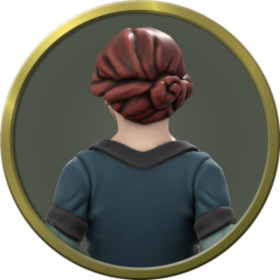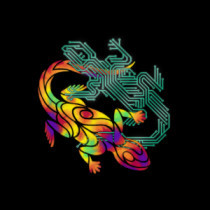Weddings, what rowdy affairs they are. And they seem to hold no more meaning that some prayers, some inheritance, and all that carry on— Aitor III Larramendi
Whether you love weddings or hate them, within
Cuerero and the
Daiturian faith as a whole weddings are key milestone within a person's life. They are the culmination of sometimes years of courting, engagements, and planning.
Clothing
Upon the day of a wedding, both bride, groom and guests alike are expected to wear their best of clothing to celebrate the union of (occasionally) happy couple. Depending upon the class and wealth of those who contribute to the wedding expenses, these garments and accessories can grow to become some of the most prized of possessions. It is not uncommon to hear of two women wearing the same gown (bar some adaptions) even generations apart.
Grandmother and granddaughter looked alike upon their wedding days, same dress hung upon their slim figures and same toothy grin upon their tanned skins.
Hair
The Del
In Currean tradition, a vast majority of women do not tie their hair, instead leaving it down or braiding it for convenience. However, upon a woman's marriage day (and sometimes in the later stages of engagement) it has become a tradition to tie hair up into 'Rudkwek del', commonly shortened to 'Del'.
Garments
The wedding wear of the bride and groom can be costly for many reasons and often become heirlooms in lower-class families. Blue dye is hard to come across within
Cuerero in large amounts, especially
darker blue dyes.
Male
Male wear tends to vary a lot more than what is worn by female-presenting members of society upon their weddings. However, there are some common themes to which clothing is worn
- Blue clothing - Due to weddings being a mostly religious affair, blue is still worn as it is the traditional colour worn and due to it's holiness. However, unlike a woman's wear, the shirt (trousers are commonly grey or black, being the most well-kept pair a person owns) will be a of a lighter blue. This is one of the contributing factors to men's wedding wear being cheaper, alongside it's simplicity in comparison to women's garments.
- Well-kept - Clothing for weddings is expected to be in the highest condition as it can represent many things about a person (namely wealth, class, piety, etc)
Female
Dresses
Wedding dresses vary for many reasons, whether it be class, culture, or the sect of Daiturianism you believe in. Though, all dresses will often be a dark-ish shade of blue and reach to a least a woman's ankle. These dresses vary in complexity, although most veer upon the simple side without patterns, embroidery, or finery.
Cuerero and other countries with hotter climates have adapted the typical long-sleeved dress to either have shorter sleeves, or to be cut off by
Wazllgikb.
A dark blue dress is an item of pride for any woman. She should give it her utmost care and attention. So that she, in case of misfortune, can give something to her daughter if the cost is too vast when she comes of wedding age.
Headwear
Whether a woman covers her head or not during weddings (or religious events as a whole) is often a divisive subject. Usually, a woman will either wear a
Ched or a veil.
Accessories
The dress itself is a rather simple thing, despite how expensive it can be. What lends to the complexity of the gowns of the upper crust of society is the accessories they adorn themselves with.
Belts are the most common accessory, as, alongside the Wazllgikb, most of the population use them on a day-to-day basis. These can vary in quality as for the poorer lot, the belts are the ones they use in their daily toil. However, many will fork out the extra money to buy a belt especially for their wedding days.
Another common accessory are earrings. For most in society, these are heirlooms passed from mother to daughter over the generations. It is seen as a great pride and blessing to wear the same accessories that your mother or grandmother did, especially if they were a pillar of their local community.
For the same reasons, necklaces are common (perhaps more so). In the well-of parts of society, it is becoming a more common thing to gift (if you are the groom) a necklace to your future wife to be worn upon your wedding.
Rituals
Usually, the nuptial rite lasts most of a day, usually containing small ceremonies within in it. The grandeur and exact specifics vary depending on the class and wealth of the partners. Originally these affairs would last days, though as time moved on, the ritual has grown to become shorter and shorter. However, royal and particularly devout
Eitumite weddings can still last multiple days.
A wedding is perhaps the most long of days a man might experience, especially if it is his own. Though, the evening passes by, it seems, as quick a warrior's arrows betwixt merriment.
Nuyi Chako
Morning is the quietest part of the day for those who intend to marry, focused upon preparing for the wedding and the well-wishing of those not invited to either the private and quiet ceremony or the rowdy evening feast.
Separation
Weddings often being after days of separation (between three days and a week) where there are no meeting nor any form of correspondence between the bride and groom.
It is contested where this tradition arose from. Some tout it to be a test of loyalty, invented by authors and poets during the seventh and eighth century DEV. Whereas, others claim it to be from the
Kaharuponda, perhaps to re-enact the constant separation of
Kanoke and Eriyu.
The bride-meeting
After days of separation, this is the first time both bride and groom have saw one another. Usually, this is where the first lines of an Ilo Scroll are created. Before those words are written, there is an opportunity to object and both parties can walk free of this potential union, though after the start of a scroll, it must be ended. This meeting begins roughly at 8'o'clock in the morning.
Penu, ki ndilo ne chi mi kuyu ucha wuki yu wuku,
Yu ki ne chi mi rindoshi ucha kiwo ku pi yu nyuko.
— The start of an Ilo Scroll
Translation
Yes, I desire to be your wife despite fights and turmoil,
And I to be your husband despite the struggle of life and death
The Morning prayers
Morning prayers are often given upon special occasions, like holidays and funerals, otherwise worship is done in the evenings. Weddings are no different. The bride and groom are expected to visit
Mohu Nyotusu Ku (more commonly known as a Toyu) after their meeting to begin a two hour service.
This service is often the more interesting of the two services. Usually, it contains the burning of incense and the lighting of candles, common sacrifices to the gods after banning of human sacrifice. This is when the bride and groom will meet the clergyman expected to officiate the wedding.
The Full Dressing
During the morning prayers, both bride and groom will not fully dress themselves, skimping on finery until the ceremony so as not to damage items. They will return to their quarters, accompanied by close family to fully dress and prepare themselves for the wedding (such as bathing or the simple and religious practise of washing feet upon celebrations) and adding the fineries (Like the woven crown, or necklaces or whatever else accessories)
Wuyo
When it comes to afternoon, before their large ceremony, the bride and groom might stop to take some nourishment. Usually this is bread and whatever else they can afford. Though, it is in vogue currently for their to be set foods, as seen by the rise in popularity of pamphlets such as
Kho Dyodow nli Braz.
The Ceremony
The ceremony will occur in a private place, often outside, only witnessed by a clergyman, both
families and a select group of well-wishers (good friends, cousins, aunts, etc) chosen by the bride and groom.
These are usually rather simple with the reciting of
Nda Nyieriyu Yundi and some hymns sung. They usually last an hour before the guests are escorted towards the Toyu where occurs another few hours of prayers.
Reading of the Kharuponda
Perhaps the most boring few hours, depending on how devout the bride and groom are. There is some singing and some joy to it. But besides that, it is the most boring of events with merely a clergyman reading stories that the vast majority in the room might know, some perhaps off by heart.
The Three poems
After a few hours of sitting still in a stuffy building, the bride and groom are often escorted into another room within the Toyu, where they will be instructed on poems to write upon the Ilo scroll. Some believe this is how Eiryu judges a person when they pass through his chambers, and therefore is of the utmost importance to the now wed couple.
Usually, these poems are one each from the bride and groom, praising their 'good' features and wishing themselves to be happily married until death parts them. The other poem is usually just a confirmation of where and when the couple were wed and who officiated the ceremony. The clergy's poem is mostly written in
Shitonen, the ecclesiastical language, whereas the couples' poems are written in their most fluent language.
During this time, the guests either make conversation within the Toyu's foyer or they head towards the place where the evening's merriment is to take place, usually a more public area such as a community's meeting house.
Royi
The rowdiest events of the day occur during the evening, though as to be expected considering it is a celebration of the couple's union.
The feast, the Shengo Nyiro
Usually, the feast is prepared during the day by those close to the families but not close enough to attend the day's ceremonies, or by servants if the bride and groom are of decent affluence. It is served as the bride and groom enter and is usually hearty meal of meat and vegetables (varying upon the season and availability). It is often served with pastries and fruits too. Wine and other alcohols are served alongside it.
Cuerero is known for being a nation of penny-pinchers, though this is one of the rare occasions where nearly anyone is willing to spend a fortune. Sometimes, this wedding feast can be the largest meal one might experience.
The Celebration
Once food is served and ate, an evening of music and celebration begins. Family members and friends who know an instrument or who can sing mainly preform the music. Dancing and conversation continue until past midnight. It is one of the few occasions per year where a man (or woman) can get blind-drunk and no one would think too much about it.
Seclusion
After the evenings celebrations have died down slightly, the newly wedded pair are escorted (usually by the mother of the bride) to a bedchamber where they are expected to consummate their marriage. Most of the time, the bride and groom are left alone to enjoy each other’s company for a few days before they are expected to take up residence. More commonly, this residence is near the groom's family, though it is becoming a tradition to live nearby whomever has the most wealth.
Khafkii Marriage Traditions
Khafkii traditions are slightly different to those of most other Curreans due to their incorporation of foreign additions to their weddings.
Giving the Fabric
Giving the Fabric is often called 'Mekhuuch'. It is often the first gift given to the bride by her groom as it is common for a Khafkii woman to have worked, is working or will work with fabric at some point in her life.
Colours of Fabric
The fabric can be any colour, though there are traditionally some colours given.
Yellow/Orange
Yellow (or orange) is the most common colour of fabric given in celebration of a wedding. Simple yellow dresses are mainly worn by Khafkii women (as well as royalty) and it is one of the cheaper colour to find within the country.
Blue
Blue has become more common only in the last 40 years as sumptuary laws began to ease and there became an increase in social mobility for Cuerero's Khafkii inhabitants. Usually much lighter than the dress, this fabric is often more given in devout families.
Couple's money
Couple's money (Wow reef) is a more common tradition in comparison to Mhekhuuch. It is practiced, though, most commonly by
Khafkii folk and those belonging to the Eutimite sect. Upon the wedding day, gifts are often exchanged between friends, however, it is becoming more common for money to be gifted instead. Originally, this comes from one of the many Khafkii populations, having their ancestry within
Falan.







Wow! I love how much work you've put into this--so many elements of the world and its beliefs worked in really make this ritual and the traditions surrounding it come to life!
You are doing a great job! Keep creating; I believe in you!
Luridity: Where love is love and life is lived. Contains NSFW content.
Now with serialized fiction on Ream!!